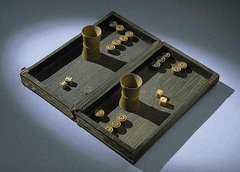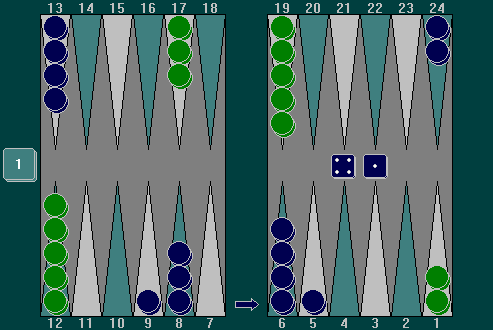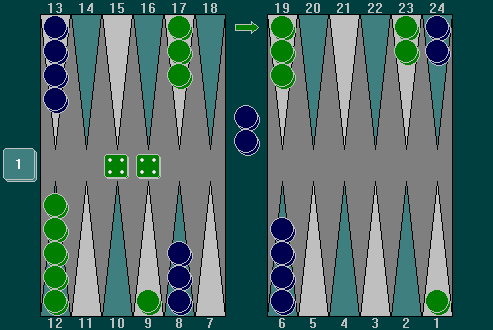Backgammon
|
|
| Contents |
History
Backgammon is the oldest known recorded game in history. Traditionally, it was believed to have originated in ancient Egypt, Sumeria, or Mesopotamia in the Persian empire (present-day Iran, Iraq, and Syria). However, more recent conclusive evidence indicates that the game originated on the eastern borders of Iran, near Afghanistan. [1] (http://www.chn.ir/english/eshownews.asp?no=4212) In English, the word backgammon is believed to be derived from "back" plus the Middle English word "gamen" (game).
Rules
Backgammon is a simple game with deep strategic elements. It does not take long to learn to play, although obscure situations do arise which require careful interpretation of the rules. The playing time for each individual game is short, so when it is not played for money it is often played in matches, for example the first to five points.
Each side of the board has a track of twelve adjacent points. The tracks are imagined to be connected on one edge of the board, making a continuous chain of twenty-four points. The points are numbered from 1 to 24, with checkers always moving from higher-numbered points to lower-numbered points. The two players move their checkers in opposite directions, so the 1-point for one player is the 24-point for the other. Some recorded games, however, keep the numbering of the points constant from the perspective of one player.
Each player begins with two checkers on his 24-point, three checkers on his 8-point, and five checkers each on his 13-point and his 6-point.
Points one to six are called the home board. A player may not bear off any checkers unless all of his checkers are in his home board. Points seven to twelve are called the outfield, points thirteen to eighteen the opponent's outfield, and points nineteen to twenty-four the opponent's home board.
At the start of the game, each player rolls one die. Whoever rolls higher starts. In case of a tie, the players roll again. Typically, when playing a sequence of games the winner of the previous game will start the next one. The players alternate turns and roll two dice at the beginning of each turn.
After rolling the dice a player must, if possible, move checkers the number of points showing on each die. For example, if he rolls a 6 and a 3, he must move one checker six points forward and another one three points forward. The dice may be played in either order. The same checker may be moved twice as long as the two moves are distinct: six and then three, or three and then six, but not nine all at once.
If a player has no legal moves after rolling the dice, because all of the points to which he might move are occupied by two or more enemy checkers, he forfeits his turn. However, a player must play both dice if it is possible. If he has a legal move for one die only, he must make that move and then forfeit the use of the other die. (If he has a legal move for either die, but not both, he must play the higher number.)
If a player rolls two of the same number (doubles) he must play each die twice. For example, upon rolling a 5 and a 5, he must play four checkers forward five spaces each. As before, a checker may be moved multiple times as long as the moves are distinct.
A checker may land on any point occupied by no checkers or by friendly checkers. Also it may land on a point occupied by exactly one enemy checker (a blot). In the latter case the blot has been hit, and is temporarily placed in the middle of the board on the bar, i.e., the divider between the home boards and the outfields. A checker may never land on a point occupied by two or more enemy checkers. Thus no point is ever occupied by checkers from both players at the same time.
Checkers on the bar re-enter the game through the opponent's home field. A roll of 1 allows the checker to enter on the 24-point, a roll of 2 on the 23-point, etc. A player with one or more checkers on the bar may not move any other checkers until all of the checkers on the bar have re-entered the opponent's home field.
When all of a player's checkers are in his home board, he may bear them off. A roll of 1 may be used to bear off a checker from the 1-point, a 2 from the 2-point, etc. A number may not be used to bear off checkers from a lower point unless there are no checkers on any higher points. For example, a 4 may be used to bear off a checker from the 3-point only if there are no checkers on the 4-, 5-, and 6-points.
A checker borne off from a lower point than indicated on the die still counts as the full die. For instance, suppose a player has only one checker on his 2-point and two checkers on his 1-point. Then on rolling 1-2, he may move the checker from the 2-point to the 1-point (using the 1 rolled), and then bear off from the 1-point (using the 2 rolled). He is not required to maximize the use of his rolled 2 by bearing off from the 2-point.
If one player has not borne off any checkers by the time his opponent has borne off all fifteen, he has lost a gammon, which counts for twice a normal loss. If a player has not borne off any checkers, and still has checkers on the bar and/or in his opponent's home board by the time his opponent has borne off all fifteen, he has lost a backgammon, which counts for triple a normal loss. Sometimes a distinction is made between pieces in the opponent's home board (triple loss) and pieces on the bar (quadruple loss).
Sample Game
A few turns from the beginning of a sample game will illustrate the rules of movement. To start the game blue rolls a 4 and green rolls a 1, so blue takes the first turn playing a 4,1. This is an unfavorable opening roll, arguably the worst possible, but blue uses it the best he can. He takes a checker from each of his heavy points by playing 13-9, 6-5.
It is seldom useful to have five checkers on the same point, so blue starts to spread his checkers around. He is threatening to build a prime, i.e., a blockade to prevent green's two trailing checkers from getting home. The disadvantage of blue's choice is that it isn't very safe. It leaves two blots which green might hit. Some experts prefer the less aggressive but safer move of 24-23, 13-9.
Green rolls a 4, 4. This is an extremely lucky roll. Not only can he hit both of blue's blots with 1-5*-9*, he also has two more fours to play. He may, for example play 19-23(2), moving two checkers from his 6-point to the 2-point. This leaves blue with two checkers on the bar, trying to re-enter against green's home board, which has two points blocked by green.
Green was wise to hit twice, because it disrupts blue's efforts to build a prime, and it puts blue considerably behind in the race. Those two checkers must come all the way around the board before blue can begin to bear off.
In contrast, green's decision to make the 2-point was strategically dubious. Though it may prevent blue from entering with both checkers, and there is some chance green will be able to build a strong home board before blue gets organized, increasing the chances of winning a gammon, the disadvantage is that green will now find it difficult to build a prime. If blue manages to make an advanced anchor, i.e., get two of his back checkers on green's 3-, 4-, or especially the 5- point, then green's blocking game is busted.
Green would be in better shape had he played 12-16(2), keeping open the option to block or attack depending on blue's next roll.
Blue rolls 5, 2. The only legal move is Bar-20. The two can't be played from the bar because green owns his 2-point, and until blue has played all his checkers off the bar, he can't play anywhere else. Therefore the 2 is forfeited and blue's turn is over.
Bg_sg_w2.png
image:bg_sg_w2.png
Green got what he wanted, in that blue was not able to enter both checkers, but the fight is far from over. Green must hit the blot on his next roll, or else blue has a fifty-fifty chance to cover his blot and take a fairly strong position. Even if green does hit, blue has many rolls to hit back. A war for green's 5-point will shape the character of the game in the near future.
Maximum checkers on a point
The international rules allow for any number of the same player's checkers to be placed on the same point. A variant rule (played mostly by Egyptians and viewed by its users as making the gameplay more interesting) limits the number of checkers on each point to five, thus restricting some moves that might otherwise be made.
Backgammon as a Gambling Game
Due to the large element of luck, backgammon is often played as a gambling game. To increase the importance of positional judgment, a doubling cube is usually used. A doubling cube is a 6 sided die that instead of the numbers 1, 2, 3, 4, 5, 6 on it, has the numbers 2, 4, 8, 16, 32, 64 on it. If a player believes his position to be superior he may, before his turn, double, i.e., demand that the game be played for twice the current stakes. The doubling cube is placed with the 2 side face up to show that the game's value has been doubled. His opponent must either accept the challenge or resign the game on the spot. Thereafter the right to redouble (double again) belongs exclusively to the player who last accepted a double. In this case, the cube is placed with the 4 face up.
The game rarely is redoubled beyond 4 times the original stake, but there is no theoretical limit on the number of doubles. Even though 64 is the highest number on the doubling cube, the stakes may rise to 128, 256, 512 and so on. A common rule allows beavers - the right for a player to immediately redouble when offered the doubling cube. In this way, the stakes of the game can rise dramatically.
Computer Backgammon
The first strong computer opponent was BKG 9.8. It was programmed by Hans Berliner in the late 1970s on a PDP-10 as an experiment in evaluating board positions. Early versions of BKG played badly even against poor players, but Berliner noticed that the critical mistakes the program made were always at phase changes. He applied basic principles of fuzzy logic to smooth out the transition between phase changes, and by July 1979, BKG 9.8 was ready to play against then current world champion Luigi Villa. It won the match, 7-1, becoming the first computer program to defeat a world champion in any game, although this was mostly a matter of luck, as the computer happened to get better die rolls than its opponent in that match.
Beginning in the late 1980s, creators of backgammon-playing software began to have even more success with a neural network approach. TD-Gammon, developed by Dr. Gerald Tesauro of IBM, was the first of these computer programs to play at or near the expert level. This program's neural network was trained using Temporal Difference learning applied to data generated from self-play.
This line of research has resulted in two modern commercial programs, Jellyfish and Snowie, the shareware BGBlitz (http://www.bgblitz.com) (implemented in Java), and the non-commercial GNU Backgammon (http://www.gnubg.org), that play on a par with the best human players in the world. It is worth noting that without their associated "weights" tables which represent hours or even months of tedious neural net training, these programs play no better than a human child.
It is interesting to contrast the development of backgammon software to chess software:
- For backgammon, neural networks work better than any other methods so far. For chess, brute force searching, with sophisticated pruning and other refinements, works better than neural networks.
- Every advance in the power of computer hardware has significantly improved the strength of chess programs. In contrast, additional computing power appears to improve the strength of backgammon software only marginally.
- For both backgammon and chess, it is at present unclear whether the best computer or the best human is best overall. For most other games, one or the other is unambiguously stronger.
There are several thriving communities of on-line real-time backgammon play, for example FIBS (http://www.fibs.com/), the First Internet Backgammon Server.
Other games played on the same board
A number of variations on the rules of backgammon exist, which are usually considered different games since the playing strategy is different. They are far less popular than backgammon in the English-speaking world, but still enjoy a certain following in Mediterranean countries.
The most popular of those is probably Makhbusa. In this game all 15 pieces of each player begin at position 24. A piece hit is not placed on the bar. Rather the hitting piece sits on top of the hit piece forming a block i.e. it is identical to two pieces of the hitting color and cannot be hit again. A final twist is that you have to bring your first piece to the opponent's home board before you can move any other piece.
Another variation is the so-called Runte Rule. This rule allows the player to move his checkers both backwards and forwards within his own home board. The player cannot move the checker in such a way that it lands outside of his home board. The rule was created to increase the possibility of scoring backgammons and gammons, because it allows one to trap the opponent for longer.
In Greece, there are three main games, known as Tavli, Plakato and Portes. Portes resembles the well-known game. The three are normally played consecutively, one after another.
See also: Tables, Hypergammon, Tapa, Nackgammon, Longgammon, Acey-Deucey, Narde, Crazy Narde, Sugoroku
External links
- Free multiplayer backgammon game (http://oneplay.com/games/backgammon/backgammon.jsp) as Java applet
- The Origins of Backgammon (http://www.iranian.ws/iran_news/publish/article_4743.shtml)
- http://perso.wanadoo.fr/bckg/english - The Origin of Backgammon.
- Timeline of Backgammon in England (http://www.bits.bris.ac.uk/imran/games/chrono.html)
- http://www.chicagopoint.com/links.html - large collection of backgammon links.
- http://www.chicagopoint.com/calendar.html - calendar of coming tournaments.
- http://www.gammonvillage.com weekly articles, news.
- http://www.gnubg.org - open source neural net based backgammon program.
- http://www.fibs.org - First Internet Backgammon Server.
- http://www.dailygammon.com - Free service, internet version of postal
- http://www.backgam.com - Backgammon photography (personal site of former US co-champion, with photos of many prominent backgammon players and tournaments)ca:Backgammon
cs:Vrhcáby da:Backgammon de:Backgammon el:Τάβλι es:Backgammon fr:Backgammon ru:Нарды he:שש בש it:Backgammon ja:バックギャモン la:Nerdiludium nl:Backgammon pl:Tryktrak pt:Gamão sl:Backgammon fi:Backgammon sv:Backgammon tr:Tavla




